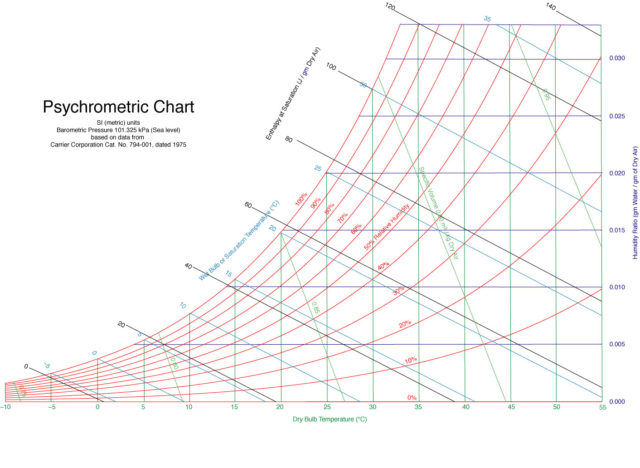The following starts with a hands-on experiment for determining relative humidity, then has some questions related to relative humidity and evaporation that don’t require the experiment to answer. In order to do the experimental part, you need a glass thermometer, some cotton balls, some string, and the graph below. If you have rubbing alcohol and acetone (fingernail polish remover) you can do even more. But if all you have is water, you can determine relative humidity. Do determine relative humidity, first take the temperature of the air. This is called the “Dry Bulb” temperature. Then wrap cotton completely around the tip (the red end) of the thermometer and tie it on. Wet the cotton, squeeze out the excess. Then wave the thermometer back and forth in the air. As you do so, the water will start evaporating from the cotton and will cool the thermometer. Check the temperature and you should notice that it is cooling. Keep waving it back and forth until the temperature bottoms out and it does not become any cooler. This is the “Wet Bulb” temperature. With these two values and the chart below, you can approximate the relative humidity.
I then have my students repeat the wet-bulb temperature experiment with rubbing alcohol and acetone. What they will find is that both of those will cool the thermometer even further. Most of the girls in the class are familiar with the “cold” feeling of acetone (fingernail polish remover). This experiment explains why this is – the acetone evaporates rapidly, removing latent heat. The alcohol and acetone are not used to determine relative humidity – only the evaporation of water is used for that.evaporation and latent heat
The answer key does not contain any information for the first part, because it depends on the conditions of the experiment. But it does have answers to the second part, which are questions about relative humidity and evaporation:evaporation and latent heat_KEY
This chart is needed to calculate Relative Humidity from the two measurements. It is not as confusing as it first appears. Start with your dry-bulb measurement. Find the vertical green line that represents your dry bulb temperature (most likely your measurement will be in-between two of them). Now find the light blue lines that are moving at an angle – these are the web-bulb measurements. Yours will likely be in-between two of them. The spot on the graph where your vertical dry-bulb line intersects with your angled wet-bulb line will land somewhere between the curved red lines. The red lines are values of relative humidity. Estimate where you are between them and that’s your answer.




